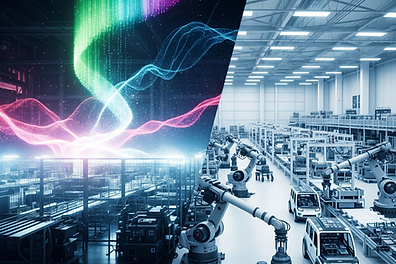Argenic & Generative AI
Automate content creation, accelerate innovation, personalize experiences, and drive operational efficiency, ultimately empowering organizations to achieve complex goals Autonomously.
Generative AI automates the creation of new content (text, images, code, audio) or designs, accelerating innovation, personalizing experiences, and improving efficiency. It can be used for rapid prototyping, content generation, synthetic data creation, and creative design, opening new possibilities for product development, marketing, and customer interaction. Agentic AI can make decisions, plan, and execute complex, multi-step tasks autonomously to achieve a specific goal, often interacting with various tools and environments without continuous human supervision.
The Generative AI aspect of this service is focused on the automated creation of novel content in various modalities. This goes beyond simple content manipulation; it involves algorithms learning patterns from vast datasets to produce entirely new, original outputs.
-
Content Generation:
-
Text: Automatically drafting articles, reports, marketing copy, social media posts, product descriptions, email campaigns, and even entire narratives. This includes summarization, translation, paraphrasing, and expanding upon provided prompts.
-
Images & Video: Generating original images, illustrations, product mock-ups, marketing visuals, and short video clips based on text descriptions or reference data. This can include creating unique visual assets for branding, advertising, or virtual environments.
-
Code: Automating code generation, suggesting code completions, debugging assistance, and even translating code between different programming languages. This significantly accelerates software development cycles and reduces manual coding effort.
-
Audio: Producing synthetic speech, music compositions, sound effects, or even entire soundtracks for various applications, such as voice assistants, podcasts, or game development.
-
Designs: Creating novel product designs, architectural blueprints, fashion designs, or user interface (UI) layouts, often optimizing for specific parameters like aesthetics, functionality, or material usage.
-
-
Key Applications & Benefits:
-
Rapid Prototyping: Quickly generating multiple design iterations, product concepts, or content variations for testing and feedback, drastically reducing time-to-market.
-
Personalized Experiences: Crafting highly customized content (e.g., personalized marketing messages, product recommendations, or user interface layouts) tailored to individual user preferences and behaviors, enhancing engagement and conversion rates.
-
Synthetic Data Creation: Generating realistic synthetic datasets for training other AI models, testing software, or simulating scenarios, especially valuable when real-world data is scarce, sensitive, or costly to acquire.
-
Creative Design & Ideation: Serving as a powerful brainstorming tool, generating novel ideas, concepts, and designs that human designers might not conceive, pushing the boundaries of creativity.
-
Improved Efficiency: Automating repetitive and time-consuming content creation tasks, freeing up human resources for more strategic and creative endeavors.
-
Scalability: Enabling the production of content at an unprecedented scale, meeting the demands of large-scale marketing campaigns, personalized content delivery, or extensive product portfolios.
-
The Agentic AI component elevates the service from content generation to autonomous decision-making and task execution. These AI agents are designed to understand high-level goals, break them down into actionable steps, and execute those steps by interacting with various tools and environments, often without continuous human oversight.
-
Autonomous Operation:
-
Goal-Oriented Planning: Agents can interpret a complex goal (e.g., "research market trends for Q3 2025 in the consumer electronics sector" or "resolve customer support ticket #12345") and autonomously formulate a multi-step plan to achieve it.
-
Decision-Making: They can evaluate different options, make choices based on defined parameters or learned strategies, and adapt their plans in real-time as new information becomes available or conditions change.
-
Tool Utilization: Agents can seamlessly integrate with and utilize various external tools and APIs, such as search engines, databases, CRM systems, project management software, communication platforms, or even other Generative AI models, to gather information, perform actions, and execute tasks.
-
Environment Interaction: They can operate within digital environments, navigating websites, filling forms, extracting data, or manipulating digital objects to achieve their objectives.
-
Complex Task Execution: Automating end-to-end processes that require reasoning, problem-solving, and sequential actions, such as managing a marketing campaign, automating IT operations, or handling complex customer service queries.
-
-
Key Applications & Benefits:
-
Automated Workflows: Transforming manual, multi-stage business processes into fully automated workflows, significantly boosting operational efficiency and reducing human error.
-
Proactive Problem Solving: Identifying potential issues or anomalies and taking autonomous corrective actions or alerting human operators with comprehensive context.
-
Personalized Customer Interaction: Powering advanced chatbots and virtual assistants that can not only understand complex queries but also proactively resolve issues, retrieve information, and execute transactions.
-
Research & Analysis: Conducting autonomous research, data gathering, and analysis from disparate sources to generate insights, reports, or recommendations.
-
Dynamic Product Development: Agents can automate aspects of the product development lifecycle, from ideation and design to testing and deployment, by interacting with design tools, code repositories, and testing environments.
-
Reduced Human Supervision: Minimizing the need for constant human intervention, allowing teams to focus on higher-value strategic tasks.
-
Synergistic Power of Generative and Agentic AI:
The true power of this service lies in the synergy between Generative AI and Agentic AI. Agentic AI can leverage Generative AI to:
-
Generate responses or content needed for its tasks (e.g., an agent handling a customer query might use Generative AI to draft a personalized email).
-
Create synthetic data for testing its own decision-making processes.
-
Design new tools or strategies to achieve its goals.
Conversely, Generative AI models can be deployed by Agentic AI as tools within larger, autonomous workflows. This integrated approach opens up unprecedented possibilities for hyper-automation, creating highly intelligent and adaptive systems that can drive innovation, personalize experiences at scale, and radically improve efficiency across the entire enterprise. This service empowers businesses to move towards a future where AI not only assists but actively drives strategic outcomes.
